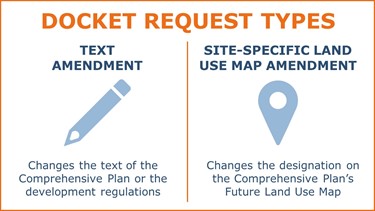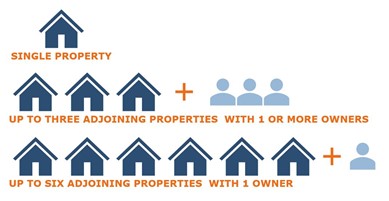Annual Docket Requests
The Comprehensive Plan Update
The City of Sammamish invites the public to weigh in on its future through its comprehensive planning effort, “Envision Sammamish 2044.” While the Annual Docket Process allows the City Council and Planning Commission to consider updates, amendments, or revisions each year, the City's Comprehensive Plan goes through a complete update every 10 years. The 2024 Comprehensive Plan Update is well underway and we encourage all residents, homeowners, and renters alike, along with our business and community leaders, to join a conversation that shapes the City’s future.
If you'd like to suggest items or amendments to be considered as part of the Comprehensive Plan update, please use the submission form located on the home page of EnvisionSammamish2044.org.
Submit your comments to comment@envisionsammamish2044.org
Questions? Please reach out to info@envisionsammamish2044.org
The Docket Request Process
Each year, the City's Planning Commission and City Council consider updates, amendments, or revisions of the Comprehensive Plan and the Sammamish Municipal Code development regulations.
The first step in this process is the docket request, which can be submitted throughout the year using the online Docket Request form.
Docket Request Types
Applicants must decide between two docket request types based on the amendments desired. Each type has a slightly different process detailed below.

Text Amendments
Text amendments include additions, modifications or corrections to the text of the Comprehensive Plan or the Sammamish Municipal Code. Applicants are strongly encouraged to submit a Text Amendment Guidance Form before submitting a Docket Request.
Submit Text Amendment Guidance Form
The guidance form helps staff understand applicant goals so that they can make recommendations to assist applicants in submitting the Docket Request Form.
Site-Specific Land Use Map Amendments
Site-Specific Land Use Map amendments may be requested for a single property or for small groups of properties as detailed below.

Pre-Application Conference is required before a Docket Request Form for a Site-Specific Land Use Map Amendment can be submitted.
The Pre-Application Conference is an in-person meeting designed to help those interested in applying for a Site-Specific Land Use Map Amendment learn more about the application requirements and process.
The fee for a Pre-Application Conference will be collected before the conference begins. Please refer to the latest version of the Fee Schedule for the amount.
Docket Request 2022
Sammamish Municipal Code Development Regulation Text Amendment
APPLICANT:
City Staff
PROPOSED CHANGES:
1. Add roadway segment and corridor level of service standards to the Comprehensive Plan and Municipal Code to address transportation level of service standards and capital facilities needs and associated environmental impacts.
APPLICANT:
Mary Wictor
PROPOSED CHANGES:
2. Update clearing and grading regulations:
- Adjust the City’s threshold limit(s) for when SEPA is triggered during clearing and grading.
- Develop lifetime limits on certain types of clearing and grading.
- Consider a 100 cubic yard exemption threshold for clearing and grading and lowering the thresholds for critical areas.
- Review and update the definition for “fill” to prevent safety issues, ensure stability, and avoid adverse water quality impacts.
3. Update tree regulations:
- Specify pruning limits on tree/plant species.
- Provide tree removal options for property owners in cases of problem trees or lack of water.
- Develop rules or guidance around removing invasive species, right-plant right-place, and encouraging snags as appropriate.
4. Research and develop or clarify lighting regulations to specify: number of allowed lights; location of lighting; lighting types, size, brightness, shielding, and allowed uses.
5. Develop and implement a septic management program that would inventory the City’s remaining septic systems, perform outreach to septic system owners, create a loan program for future sewer connections, identify septic system failing points, and identify when sewer should be connected.
Below are common questions related to the amendment process.
What is the Comprehensive Plan?
As a city planning under the Growth Management Act (Chapter 36.70A RCW), Sammamish must adopt a Comprehensive Plan and review and update it every eight years. The Comprehensive Plan includes goals, objectives, policies, actions, and standards that are intended to guide day-to-day decisions by elected officials and local government staff. The Comprehensive Plan is the City’s official policy statement on how it will manage growth. The City of Sammamish adopted its first Comprehensive Plan in 2003 as well as a full update in 2015. The 2015 Comprehensive Plan includes mandated and optional elements and serves as a framework for decisions over a 20-year planning period focused on land use, housing, capital facilities, utilities, parks and recreation, and environment, and conservation.
What are Development Regulations?
The Revised Code of Washington 36.70A.030(7) defines development regulations as the controls placed on development or land use activities by a county or city, including, but not limited to, zoning ordinances, critical areas ordinances, shoreline master programs, official controls, planned unit development ordinances, subdivision ordinances, and binding site plan ordinances as well as any related amendments to those items. Sammamish's development regulations are found in the Sammamish Municipal Code.
How is a Site-Specific Land Use Map Amendment Different From a Zoning Reclassification?
A Site-Specific Land Use Map Amendment changes the future land use designation for a property/properties and a zone reclassification changes the zoning of the property on the current zoning map.
Should City Council decide to approve the amendment proposal, their approval will be contingent on the approval of a Zone Reclassification.
Applicants have 90 days after City Council approval to submit a Zone Reclassification Application. A Zone Reclassification is a Type 3 land use action that is subject to a hearing and decision by the Hearing Examiner.
What Happens After I Submit a Request?
Our online system will provide you with an auto-confirmation upon submittal and will email a pdf copy of your form. After this, staff will review your request for the following: Completeness (ensuring all required materials are provided and sufficient information is included
- Whether the request meets the requirements of the Sammamish Municipal Code
- Alignment of the request with the City work plan, current policies, and programmatic priorities; and
- Whether City staff have the time & resources to do a full review of the request in the following year.
The above assessment, along with the information provided in your request, will be integrated into a presentation that will be given to the Planning Commission and City Council.
Applicants are strongly encouraged to attend the Planning Commission and City Council meetings and have the opportunity to provide comments on their request at these meetings if they choose to do so.
Who Decides Whether an Amendment Proposal Is Approved?
The City Council has decision-making authority over all Comprehensive Plan AND development regulation amendment proposals. The City Council has broad authority to approve, deny, modify, or defer an amendment proposal
